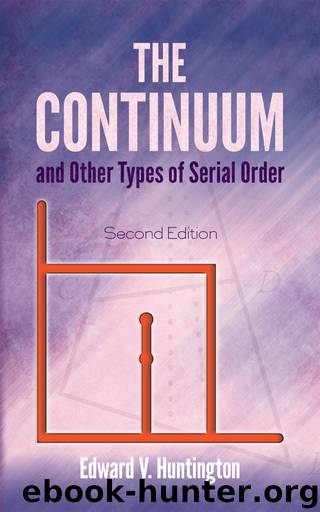THE CONTINUUM and Other Types of Serial Order by Edward V. Huntington

Author:Edward V. Huntington [Edward V. Huntington]
Language: eng
Format: epub
Publisher: Dover Publications
Published: 2017-11-07T05:00:00+00:00
CHAPTER V
CONTINUOUS SERIES: ESPECIALLY THE TYPE θ OF THE REAL NUMBERS
54. In the preceding chapters we have considered the discrete series (§ 21) and the dense series (§ 41); we turn now to the study of the linear continuous series, which are the most important for algebra.
A continuous series in general is defined as any series which satisfies postulates 1–3 of § 12, and also Dedekind’s postulate (C1, below) and the postulate of density (C2); a linear continuous series is then any continuous series which satisfies also a further condition, which I shall call the postulate of linearity (C3).
POSTULATE C1.* (Dedekind’s postulate.) If K1 and K2 are any two non-empty parts of K, such that every element of K belongs either to K1 or to K2 and every element of K1 precedes every element of K2, then there is at least one element X in K such that:
(1) any element that precedes X belongs to K1, and
(2) any element that follows X belongs to K2.
This is the same as postulate N1 in § 21.
POSTULATE C2. (Postulate of density.) If a and b are elements of the class K, and a < b, then there is at least one element x in K such that a < x and x < b.
This is the same as postulate H1 in § 41.
POSTULATE C3.† (Postulate of linearity.) The class K contains a denumerable subclass R (§ 37) in such a way that between any two elements of the given class K there is an element of R.
The consistency and independence of these postulates will be discussed in § 63 and § 64; postulate C2 is clearly redundant whenever postulate C3 is assumed.
55. The most familiar example of a linear continuous series is the class of points on a line, say one inch long, the relation a < b signifying that a lies on the left of b. Dedekind’s postulate is satisfied in this system, since if K1 and K2 are two parts of the kind described in the postulate, there will be a point of division on the line (either the last point of K1 or the first point of K2), which will serve as the point X demanded in the postulate. The postulate of density is also clearly satisfied, since between any two points of the line other points can be found. Finally, to see that the postulate of linearity holds, take as the subclass R the class of all points of the line whose distances from one end are rational fractions of an inch.
An example of a continuous series which is not linear is the class of all points (x, y) of a square (including the boundaries), arranged in order of magnitude of the x’s, or, in case of equal x’s, in order of magnitude of the y’s. This series is continuous (satisfying postulates C1 and C2), but no subclass R of the kind demanded in postulate C3 is possible within it; for, if there were such a subclass it would
Download
This site does not store any files on its server. We only index and link to content provided by other sites. Please contact the content providers to delete copyright contents if any and email us, we'll remove relevant links or contents immediately.
Modelling of Convective Heat and Mass Transfer in Rotating Flows by Igor V. Shevchuk(6226)
Weapons of Math Destruction by Cathy O'Neil(5833)
Factfulness: Ten Reasons We're Wrong About the World – and Why Things Are Better Than You Think by Hans Rosling(4489)
Descartes' Error by Antonio Damasio(3166)
A Mind For Numbers: How to Excel at Math and Science (Even If You Flunked Algebra) by Barbara Oakley(3104)
Factfulness_Ten Reasons We're Wrong About the World_and Why Things Are Better Than You Think by Hans Rosling(3046)
TCP IP by Todd Lammle(3013)
Applied Predictive Modeling by Max Kuhn & Kjell Johnson(2908)
Fooled by Randomness: The Hidden Role of Chance in Life and in the Markets by Nassim Nicholas Taleb(2861)
The Tyranny of Metrics by Jerry Z. Muller(2849)
The Book of Numbers by Peter Bentley(2779)
The Great Unknown by Marcus du Sautoy(2538)
Once Upon an Algorithm by Martin Erwig(2474)
Easy Algebra Step-by-Step by Sandra Luna McCune(2469)
Lady Luck by Kristen Ashley(2416)
Practical Guide To Principal Component Methods in R (Multivariate Analysis Book 2) by Alboukadel Kassambara(2380)
Police Exams Prep 2018-2019 by Kaplan Test Prep(2358)
All Things Reconsidered by Bill Thompson III(2261)
Linear Time-Invariant Systems, Behaviors and Modules by Ulrich Oberst & Martin Scheicher & Ingrid Scheicher(2233)
